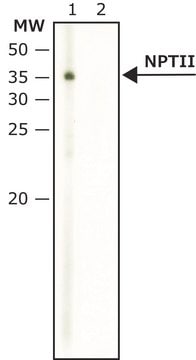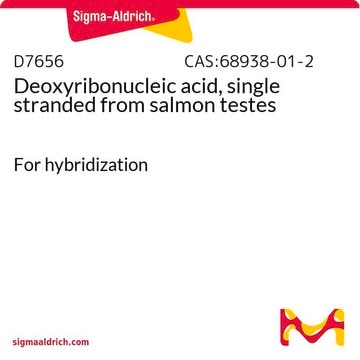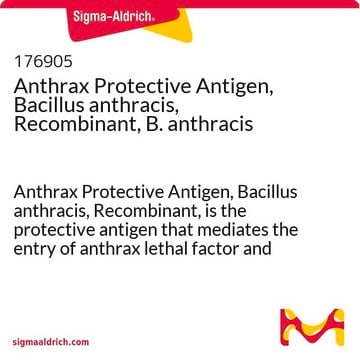176908
Anthrax Protective Antigen, Bacillus anthracis, Nicked, Recombinant, B. anthracis
Synonyme(s) :
PA 63, PA 63
Se connecterpour consulter vos tarifs contractuels et ceux de votre entreprise/organisme
About This Item
Code UNSPSC :
12352202
Nomenclature NACRES :
NA.77
Produits recommandés
Forme
lyophilized
Niveau de qualité
Fabricant/nom de marque
Calbiochem®
Conditions de stockage
OK to freeze
Conditions d'expédition
ambient
Température de stockage
2-8°C
Description générale
Recombinant, Bacillus anthracis anthrax protective antigen (nicked) expressed in a specialized strain of B. anthracis. PA63 is the carboxyl-terminal 63-kDa fragment obtained by the proteolytic cleavage of the receptor-bound protective antigen (PA), one of the three proteins that comprise anthrax toxin. Unlike native PA, PA63 oligomerizes to form a ring-shaped heptamer that binds up to three copies of EF and/or LF competitively and with high affinity (Kd ~1 nM). Whereas native PA persists on the cell surface, the heptamer is endocytosed, presumably because oligomerization aggregates anthrax toxin receptor. The endocytosed toxic complexes are trafficked to endosomal compartments where the low pH causes the PA63 heptamer to insert into the membrane and form a water-filled channel.
Recombinant, Bacillus anthracis anthrax protective antigen(nicked) expressed in a special strain of B. anthracis. PA63 is the carboxyl-terminal 63-kDa fragment obtained by the proteolytic cleavage of the receptor-bound protective antigen (PA), one of the three proteins that comprise anthrax toxin. Unlike native PA, PA63 oligomerizes to form a ring-shaped heptamer that binds up to three copies of EF and/or LF competitively and with high affinity (Kd ~1 nM). Whereas native PA persists on the cell surface, the heptamer is endocytosed, presumably because oligomerization aggregates anthrax toxin receptor. The endocytosed toxic complexes are trafficked to endosomal compartments where the low pH causes the PA63 heptamer to insert into the membrane and form a water-filled channel.
Actions biochimiques/physiologiques
Cell permeable: no
Primary Target
EF and/or LF
EF and/or LF
Product does not compete with ATP.
Reversible: no
Avertissement
Toxicity: Standard Handling (A)
Forme physique
Lyophilized from 100 mM NaCL, 10 mM BIS-Tris propane, 1.25% trehalose, pH 8.5.
Reconstitution
Following reconstitution aliquot and freeze (-20°C or- 70°C) for long term storage or refrigerate (4°C) for short-term (few hours) storage. Avoid rapid freeze-thaw cycles of solutions. Stock solutions are stable for up to 3 months at -20°C or -70°C.
Reconstitute in sterile 50% glycerol or sterile, distilled H₂O to a final concentration of 1 mg/ml. Addition of BSA to a concentration of 1 mg/ml may enhance stability.
Remarque sur l'analyse
Single major band at 63 kD by SDS-PAGE
Autres remarques
Mogridge, J., et al. 2002. Proc. Natl. Acad. Sci. USA99, 7045.
Nassi, S., et al. 2002. Biochemistry41, 1445.
Singh, Y., et al. 1999. Infect. Immun.67, 1853.
Leppla, S.H. 1988. Methods Enzymol.165, 103.
Nassi, S., et al. 2002. Biochemistry41, 1445.
Singh, Y., et al. 1999. Infect. Immun.67, 1853.
Leppla, S.H. 1988. Methods Enzymol.165, 103.
Informations légales
CALBIOCHEM is a registered trademark of Merck KGaA, Darmstadt, Germany
Code de la classe de stockage
11 - Combustible Solids
Classe de danger pour l'eau (WGK)
WGK 1
Point d'éclair (°F)
Not applicable
Point d'éclair (°C)
Not applicable
Certificats d'analyse (COA)
Recherchez un Certificats d'analyse (COA) en saisissant le numéro de lot du produit. Les numéros de lot figurent sur l'étiquette du produit après les mots "Lot" ou "Batch".
Déjà en possession de ce produit ?
Retrouvez la documentation relative aux produits que vous avez récemment achetés dans la Bibliothèque de documents.
Notre équipe de scientifiques dispose d'une expérience dans tous les secteurs de la recherche, notamment en sciences de la vie, science des matériaux, synthèse chimique, chromatographie, analyse et dans de nombreux autres domaines..
Contacter notre Service technique








